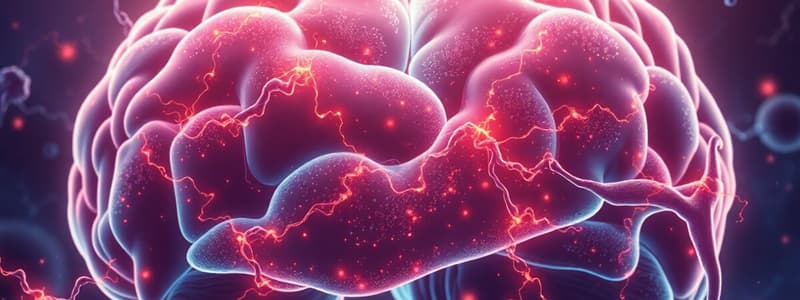Podcast
Questions and Answers
Which of the following is a primary effect of stimulating α1-adrenergic receptors?
Which of the following is a primary effect of stimulating α1-adrenergic receptors?
- Vasoconstriction (correct)
- Decreased heart rate
- Uterine relaxation
- Bronchodilation
Which type of G protein are α2-adrenergic receptors coupled to?
Which type of G protein are α2-adrenergic receptors coupled to?
- Gt
- Gi (correct)
- Gs
- Gq
What is the primary effect of β1-adrenergic receptor stimulation on the heart?
What is the primary effect of β1-adrenergic receptor stimulation on the heart?
- Vasodilation
- Decreased heart rate
- Increased heart rate (correct)
- Bronchoconstriction
Which of the following is a common effect of β2-adrenergic receptor activation?
Which of the following is a common effect of β2-adrenergic receptor activation?
In which tissue are β3-adrenergic receptors primarily located?
In which tissue are β3-adrenergic receptors primarily located?
What is the effect of α2-receptor activation on norepinephrine release?
What is the effect of α2-receptor activation on norepinephrine release?
Which second messenger is increased by activation of Gs-coupled adrenergic receptors?
Which second messenger is increased by activation of Gs-coupled adrenergic receptors?
Which of the following catecholamines has a higher affinity for α-receptors than β-receptors?
Which of the following catecholamines has a higher affinity for α-receptors than β-receptors?
What effect does an α1-antagonist have on blood pressure?
What effect does an α1-antagonist have on blood pressure?
Which of the following is a therapeutic use of β1-antagonists (beta-blockers)?
Which of the following is a therapeutic use of β1-antagonists (beta-blockers)?
Flashcards
Adrenergic Receptors
Adrenergic Receptors
Receptors targeted by catecholamines like norepinephrine and epinephrine, triggering sympathetic responses.
α1-Adrenergic Receptors
α1-Adrenergic Receptors
Located on postsynaptic effector cells; stimulation leads to smooth muscle contraction.
α2-Adrenergic Receptors
α2-Adrenergic Receptors
Located on presynaptic nerve terminals; activation inhibits norepinephrine release.
β1-Adrenergic Receptors
β1-Adrenergic Receptors
Signup and view all the flashcards
β2-Adrenergic Receptors
β2-Adrenergic Receptors
Signup and view all the flashcards
β3-Adrenergic Receptors
β3-Adrenergic Receptors
Signup and view all the flashcards
Norepinephrine Affinity
Norepinephrine Affinity
Signup and view all the flashcards
Epinephrine Affinity
Epinephrine Affinity
Signup and view all the flashcards
Adrenergic Agonists
Adrenergic Agonists
Signup and view all the flashcards
Adrenergic Medications
Adrenergic Medications
Signup and view all the flashcards
Study Notes
- Adrenergic receptors, or adrenoceptors, are G protein-coupled receptors targeted by catecholamines, especially norepinephrine (noradrenaline) and epinephrine (adrenaline).
- Many cells possess adrenergic receptors; catecholamine binding generally triggers a sympathetic (or sympathomimetic) response.
- The two main classes of adrenergic receptors are α and β, with several subtypes.
- α-receptors have subtypes α1 and α2.
- β-receptors have subtypes β1, β2, and β3.
- Adrenergic receptors are activated by medications like beta blockers, β2 agonists, and α2 agonists, treating conditions like high blood pressure and asthma.
Alpha-Adrenergic Receptors (α-Adrenoceptors)
- α-receptors have two subtypes: α1 and α2.
- α1-receptors are located on postsynaptic sympathetic effector cells, such as smooth muscle.
- α2-receptors are located on presynaptic nerve terminals and, to a lesser extent, on postsynaptic effector cells.
α1-Adrenergic Receptors
- α1-adrenergic receptors are Gq-coupled receptors.
- They activate phospholipase C, increasing inositol trisphosphate (IP3) and diacylglycerol (DAG) levels.
- This results in increased intracellular calcium and activation of protein kinase C, leading to cellular effects.
- Stimulation of α1-receptors typically leads to smooth muscle contraction.
- Location: Smooth muscle cells in blood vessels, iris, and genitourinary system.
- Effects include vasoconstriction, increased blood pressure, mydriasis (pupil dilation), and contraction of the bladder sphincter.
- α1-agonists like phenylephrine are used as decongestants and to raise blood pressure.
- α1-antagonists like prazosin are used to treat hypertension and benign prostatic hyperplasia (BPH).
α2-Adrenergic Receptors
- α2-adrenergic receptors are Gi-coupled receptors.
- Activation of α2-receptors inhibits adenylyl cyclase, decreasing intracellular cAMP levels.
- This results in inhibition of neurotransmitter release, smooth muscle relaxation, and other cellular effects.
- Location: Presynaptic nerve terminals, platelets, and some smooth muscle cells.
- Effects include inhibition of norepinephrine release (negative feedback), platelet aggregation, and smooth muscle contraction.
- α2-agonists like clonidine are used to treat hypertension by reducing sympathetic outflow from the central nervous system.
- α2-antagonists like yohimbine have been used to treat erectile dysfunction and as a research tool.
Beta-Adrenergic Receptors (β-Adrenoceptors)
- β-receptors have three subtypes: β1, β2, and β3.
- All β-receptors are Gs-coupled receptors.
- They activate adenylyl cyclase, increasing cAMP levels.
- This results in activation of protein kinase A and subsequent phosphorylation of intracellular proteins, leading to various cellular effects.
β1-Adrenergic Receptors
- Location: Primarily in the heart and kidneys.
- Effects include increased heart rate (chronotropy), increased contractility (inotropy), and increased renin release from the kidneys.
- β1-agonists like dobutamine are used to treat heart failure.
- β1-antagonists (beta-blockers) like metoprolol are used to treat hypertension, angina, and arrhythmias.
β2-Adrenergic Receptors
- Location: Smooth muscle of the bronchioles, uterus, blood vessels, and liver.
- Effects include bronchodilation, vasodilation, relaxation of the uterus, and increased glycogenolysis and gluconeogenesis in the liver.
- β2-agonists like albuterol are used to treat asthma and other respiratory conditions by causing bronchodilation.
- Selective β2-agonists have fewer cardiac side effects than non-selective beta-agonists.
β3-Adrenergic Receptors
- Location: Primarily in adipose tissue.
- Effects include lipolysis (breakdown of fat) and thermogenesis.
- β3-agonists like mirabegron are used to treat overactive bladder by relaxing the detrusor muscle.
Receptor Selectivity
- Norepinephrine (noradrenaline) has a higher affinity for α-receptors than β-receptors, particularly α1-receptors.
- Epinephrine (adrenaline) has a relatively equal affinity for α- and β-receptors.
- Isoproterenol is a synthetic catecholamine with high affinity for β-receptors.
- The selectivity of drugs for different adrenergic receptor subtypes allows for targeted therapeutic effects with fewer side effects.
Studying That Suits You
Use AI to generate personalized quizzes and flashcards to suit your learning preferences.




